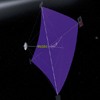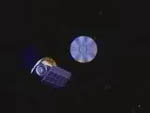 a larger 198k view. |
Engineers at the Interstellar Propulsion Research Office of NASA's Marshall Space Flight Center in Huntsville, Alabama, are devloping a rigid-yet-lightweight carbon fiber material that could be used to build just such a giant space sail.
NASA would like to be able to launch such a sailing craft --the biggest, fastest interstellar probe ever -- toward exotic destinations beyond our Solar System.
The thin reflective sails, made of composite materials, would span 440 yards. That's twice the diameter of the Louisiana Superdome. Sunlight falling on the sail would push the probe out of the Solar System and across our Milky Way galaxy.
Propulsion for later missions might use microwave beams or laser beams to drive the sail.
Flat out fast. This spacecraft would be fast, very fast. It would accelerate to a lightning-quick 58 miles per second, which is more than ten times faster than a space shuttle's speed of 5 miles per second in orbit. It could cover the distance from New York to Los Angeles in less than a minute.
The first intentional interstellar probe probably would travel beyond the edge of the Solar System to a distance of more than 23 billion miles. To astronomers that would be a distance of 250 astronomical units. One astronomical unit is the distance from Earth to the Sun -- 93 million miles.
Alpha Centauri. By comparison, if the distance from Earth to the Sun equaled one foot, Earth would be a mere 6 inches from the planet Mars, 38 feet from the planet Pluto, 250 feet from the outer boundaries of the Solar System, and an immense 51 miles from the nearest star system, which is known as Alpha Centauri.
Such a round trip from Earth out beyond our Solar System to the Alpha Centauri star system and back to Earth would take about fifteen years.
People will follow. Sail propulsion will be used for robot missions to distanct stars and then, later, for human travel.
How soon? Humankind's first planned venture outside of the Solar System could begin as early as 2010. The challenging and unprecedented 15-year journey would be the most audacious deep space mission ever undertaken.
 288k QuickTime video movie of interstellar travel by solar sail. Then click Back to return here |
Why use a sail? Old-fashioned booster rockets need so much fuel that they can't push their own weight beyond the Solar System into interstellar space. Space sails, on the other hand, require no fuel.
Imagine the wind pushing sailboats across water on Earth. The thin reflective space sails would be propelled through space by sunlight, microwave beams or laser beams.
Rays of light from the Sun would deliver Herculean momentum to the voluminous structure. Nothing this big has ever been deployed in space.
How big are they? The carbon fiber sailcloth would have a density of less than one-tenth ounce per square yard. That's the equivalent of flattening out one raisin so much that it covers a square yard.
Sails in space would have a very large surface area -- about a half-mile wide -- but would be thinner than cellophane. The sailcloth's carbon fiber material would have a thin coating of reflective aluminum.
The composite material sailcloth, rigged for interstellar flight, would be sent to space on an old-fashioned expendable space rocket. There, it would unfurl like a fan.
Sailing through the galaxy. The concept of space sails is not new. About the time Jamestown was being established as America's first permanent colony at dawn of the 17th century, German astronomer Johannes Kepler penned a letter to Italian astronomer Galileo, advocating "ship or sails adapted to the heavenly breezes" to travel to Jupiter or the Moon. Having observed that a comet's tail always faces away from the Sun, Kepler concluded that light from the Sun must exert a force that pushes its tail away.
Rays of light emanating from the Sun provide tremendous momentum that could push a solar sail to a speed of about 150,000 mph. That would allow space sails to travel an interplanetary route four to six times faster than old-fashioned rocket propulsion systems. In addition to moving remarkably faster than traditional systems, solar sails would require no fuel. The Sun would supply all of the energy.
The invention of strong lightweight composite materials in the 20th century made space sailing possible.
 a larger 198k view. |
NASA's Advanced Space Transportation Program pushes technologies to increase reliability and reduce costs. Marshall engineers are exposing space sail composite materials to harsh conditions in a simulated space environment and testing their performance and durability in extremely hot and cold temperatures.
The team needs to figure out how to build, package and unfurl a solar sail and control its direction of travel through space. Since the sail would get very close to the Sun, thermal protection will be important.
Other ways to sail. A different concept of space sailing concept is known as mini-magnetospheric plasma propulsion (M2P2). Rather than sailcloth, it blows up a huge magnetic bubble for a sail.
The probe would sail away as the bubble was pushed along by charged particles of the solar wind, instead of rays of sunlight. The charged particles of the solar wind would interact with the magnetic field to push the magnetic bubble.
| © 2000 Space Today Online | Spaceports | Rockets | STO Cover | What's New? | Top of this page |
| Search STO | About STO | Feedback | Questions |